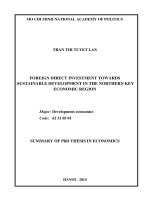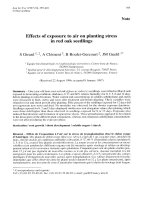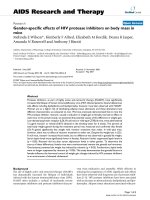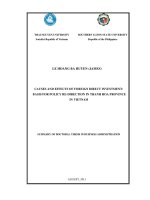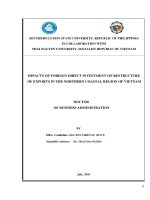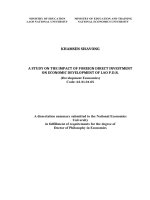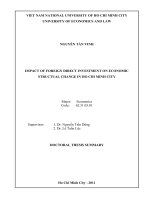Horizontal technology spillover effects from foreign dirrect investment on labor producttivty in manufacturing industry in vietnam
Bạn đang xem bản rút gọn của tài liệu. Xem và tải ngay bản đầy đủ của tài liệu tại đây (1.71 MB, 63 trang )
INSTITUTE OF SOCIAL STUDIES
UNIVERSITY OF ECONOMICS
HO CHI MINH CITY
THE HAGUE
VIETNAM
THE NETHERLANDS
====oOo====
VIETNAM-NETHERLANDS
PROGRAMME FOR M.A IN DEVELOPMENT ECONOMICS
HORIZONTAL TECHNOLOGY SPILLOVER
EFFECTS FROM FOREIGN DIRECT
INVESMENT ON LABOUR PRODUCTIVTY IN
MANUFACTURING INDUSTRY IN VIETNAM
IN PARTIAL FULFILLMENT OF THE REQUIREMENTS FOR THE DEGREE OF
MASTER OF ART IN DEVELOPMENT ECONOMICS
BY
THAN HOANG DUNG
ACADEMIC SUPERVISOR: DR. LE THI THANH LOAN
..
I'
Ho Chi Minh, November 2011
CERTIFICATION
,.
I hereby certify that the substance of this thesis has not been submitted for any
degrees and is not being currently submitted for any other degrees.
I also certify that, to the best of my knowledge, and any help received in preparing
the thesis and all sources used have been acknowledged in the thesis.
Signature
Than Hoang Dung
,.
,
•
1
ACKNOWLEDGEMENT
•
I have been receiving a great support from many people to complete this research. I
am greatly grateful to the valuable guidance, encouragement and advice from numerous
individuals including Vietnam-Netherlands program lecturers, friends and my family
members.
I would like to express my sincere appreciation to my supervisor, Dr. Le Thi Thanh
Loan, for her continuous support, for her valuable instructions, advices, comments and
immense knowledge during the completion of my thesis.
I am truly grateful to Professor Peter Calkins for his precious advices and
comments for improving the quality of the thesis, for his lectures in research and
methodology.
My sincere thanks also go to Associate Professor Nguyen Trong Hoai for his
.
lectures in econometrics, Mr Phung Thanh Binh and Mr Le Van Chon, the lectures of
Vietnam- Netherlands project, for his kind help and instructions in data analysis by Eviews
and Stata software.
Finally, I would like to send my special thanks to my friends in MDE class 14, 15
and the rest of my thesis committee for their supportive friendship, encouragement and
insightful comments.
My special gratefulness is to my family for their love, affection and for supporting
me spiritually in my learning and my career.
'
2
TABLE OF CONTENTS
1.
2.
CHAPTER 1: INTRODUCTION ............................................................................... 8
1.1.
Problem Statement .............................................................................................. 8
1.2.
Research Objectives ............................................................................................ 9
1.3.
Research Questions ........................................................................................... 10
1.4.
Research scope .................................................................................................. 10
1.5.
Organization of the Research ............................................................................. 11
CHAPTER 2: LITERATURE REVIEW .................................................................. 12
2.1.
2.1.1.
Foreign Direct Investment (FDI) ................................................................ 12
2.1.2.
Productivity and Labour Productivity ......................................................... 13
2.1.3.
Spillovers Effects ....................................................................................... 13
2.2.
3.
4.
j
Literature Review- The Concepts ..................................................................... 12
The Economics Theory ...................................................................................... 15
2.2.1.
Neoclassical Theory ................................................................................... 15
2.2.2.
Endogenous Theory ................................................................................... 17
2.3.
The Empirical Study.......................................................................................... 18
2.4.
Analysis Framework ......................................................................................... 23
CHAPTER 3: RESEARCH METHODOLOGY ....................................................... 25
3.1.
Data Collection ................................................................................................. 25
3.2.
Description ofVariables .................................................................................... 26
3.2.1.
Dependent variable: Labour productivity (LABPRO) ................................. 26
3.2.2.
Explanatory variables ................................................................................. 26
3.3.
Model Specification .......................................................................................... 28
3.4.
Estimation Strategy ........................................................................................... 29
3.5.
Hypothesis statements ....................................................................................... 30
CHAPTER 4: MODEL RESULTS AND DISCUSSION ......................................... 32
4.1.
Descriptive statistics .......................................................................................... 32
4.2.
Estimation results .............................................................................................. 34
4.2.1.
Pool regression model results ..................................................................... 34
4.2.2.
Random effects model results ..................................................................... 34
4.2.3.
Fixed effects model results ......................................................................... 35
4.3.
Results discussion ............................................................................................. 39
4.3.1.
The significant effect ofFDI spillovers in Food processing industry ........... 39
4.3.2.
The influence ofFDI spillovers in Electronics and Mechanics industry ...... 40
3
4.3.3.
5.
The effect of controllable variables on labour productivity ......................... 40
CHAPTER 5: CONCLUSION AND IMPLICATIONS ........................................... 42
5.1.
Conclusion ........................................................................................................ 42
5.2.
Implication ........................................................................................................ 42
5.3.
Research limitation ............................................................................................ 44
6.
REFERENCES ........................................................................................................ 45
7.
APPENDICES ......................................................................................................... 51
7.1.
APPENDIX A. MODEL RESULTS IN FOOD PROCESSING ......................... 51
7.2.
APPENDIX B. MODEL RESULTS IN ELECTRONICS AND MECHANICS. 56
7.3.
APPENDIX C. OVERVIEW OF FDI IN VIETNAM ........................................ 60
4
LIST OF TABLES
Table 1: The expected signs ofindependent variables ............................................................... 31
Table 2. The descriptive statistics of data sample in Food Processing industry .......................... 32
Table 3. The correlation coefficients of the variables in Food Processing industry .................... 33
Table 4. Pool regression model result in Food Processing industry ........................................... 34
Table 5. Random effects model result in Food Processing industry ........................................... 34
Table 6. Breusch-Pagan Lagrange multiplier test.. .................................................................... 35
Table 7. Fixed effects model result in Food Processing industry ............................................... 36
Table 8. Hausman test .............................................................................................................. 36
Table 9. Fixed effects model result with time fixed effects in Food Processing industry ........... 37
Table 10. Time-fixed effects test .............................................................................................. 37
Table 11. Modified Wald test ................................................................................................... 37
Table 12. The result of the most appropriate model in Food Processing industry ...................... 38
Table 13. The summary ofresu1ts in the most appropriate model in Food Processing and
Electronics and Mechanics ....................................................................................................... 39
•
5
LIST OF FIGURES
Figure 1. Foreign direct investment inflows in period 1995 - 2010 ............................................ 60
Figure 2. FDI projects licensed in period 1988 - 2009 by kinds of economic activity ............... 61
Figure 3. Structure of investment at current prices by Foreign investment sector ...................... 62
Figure 4. Structure ofGDP at current prices by Foreign investment sector ............................... 62
Figure 5. Structure ofGDP at current prices by Manufacturing industry ................................... 63
6
ABBREVIATIONS
1. BPM6 ............................................... Balance ofPayments and International
1
Investment Position Manual 6 h edition
2. FEM ................................................. Fixed Effects Regression Model
3. GSO ................................................. General Statistics Office
4. IMF .................................................. International Monetary Fund
5. MNCs ............................................... Multinational Corporations
6. OECD ............................................... Organization for Economic Co-Operation and
Development
7. REM ................................................. Random Effects Regression Model
8. VSIC ................................................ Vietnam Standard Industrial Classification
7
1. CHAPTER 1: INTRODUCTION
1.1. Problem Statement
It has been observed that within decades recently, there are some emerging
countries gaining benefits from foreign direct investment and getting significant
economic growth. Direct effects can be seen from capital inflow, growth of local
employment, application of advanced equipment, practical usage of technology.
Indirect effect can be seen from technology spillover from subsidiaries of
multinational corporations (MNCs) to local firms in host countries.
Within the period of 1960s- 1970s, the inflow ofFDI has been a significant
factor contributed to the rapid growth of Hong Kong, Singapore. The pattern also
applies to China and Vietnam in recent years as well. In particular, Vietnam is
considered as one of the fastest growing economies in the world with the average
growth rate over 7 percent per annum due to the successfulness in attracting a large
inflow ofFDI.
The debate of positive effect of FDI inflows on the economic growth of host
countries does not gain much attention; however, there is much discussion on
whether and how FDI inflows produce technology spillovers to the labour
productivity of domestic firms.
Some studies find that FDI brings positive technology spillovers to the
productivity of domestic firms by competition, demonstration and training of
employees such as Caves (1974), Blomstrom and Persson (1983), Kokko (1994),
and Liu (2002). Other studies, Aitken and Harrison (1999), Kathuria (2000),
believe that FDI generates negative effects to the labour productivity of domestic
firms by market stealing and skill stealing. These studies with mixed evidences
examine FDI technology spillovers within industries, which are called intra-industry
spillovers or horizontal spillovers.
8
.
- ---------------------------------------
In Vietnam, the number of studies on horizontal spillover effects from MNCs
to Vietnamese firms is still limited, but the mixed evidences are also found in the
studies Le Thanh Thuy (2007), Nguyen Thi Tue Anh et al. (2006), Quoc Hoi Le
and Richard Pomfret (2008), Anh Ngoc Nguyen et al. (2008) and Chuc D.
Nguyen et al. (2008).
Therefore, this research investigates horizontal technology spillover effects
from foreign direct investment on labour productivity of domestic firms in
manufacturing industry. However, due to limitation of the available data, this study
only focuses on two industries representative for low technology industry (Food
processing in particular) and high technology industry (Electronics and Mechanics
in particular), not in the whole manufacturing industry as other studies. The
research applies many panel regression models including pool regression, fixed
effects regression model (FEM) and random regression model (REM). The
interesting findings are expected to come and contribute to policymakers in the
government and firms. With the findings, the government as well as firms could
make a set of recommendations to take the best of advantage of FDI to improve
labour productivity of domestic firms in low technology industry and high
technology industry.
1.2. Research Objectives
The overall goal of this research is to analyze horizontal technology spillover
effects from FDI on labour productivity of domestic firms in low technology
industry (Food processing in particular) and high technology industry (Electronics
and Mechanics industry in particular) in Vietnam. Specifically, the research will
focus on three objectives as follows:
(i) Whether horizontal technology spillovers through FDI affect the labour
productivity of domestic firms in low technology industry as Food processing.
9
(ii) Whether horizontal technology spillovers through FDI affect the labour
productivity of domestic firms in high technology industry as Electronics and
Mechanics.
(iii) Recommendations for government planners and domestic firm managers
to take advantage of FDI to improve the labour productivity of domestic firms.
1.3. Research Questions
The research questions in this research mainly focus on investigating the
effects of horizontal technology spillovers on labour productivity of domestic firms
in low technology industry (Food processing in particular) and high technology
industry (Electronics and Mechanics industry in particular). In more detail, the
research aims to answer these following questions:
(1) Do horizontal technology spillovers through FDI give significant impact on
labour productivity of domestic firms in low technology industry as Food
processing?
(2) Is labour productivity of domestic firms in high technology industry as
Electronics and Mechanics influenced by horizontal technology spillovers?
(3) What is the set of recommendations for government planners and domestic
firm managers to take advantage of FDI to improve the labour productivity of
domestic firms?
1.4. Research scope
The research focuses on investigating horizontal technology spillover effects
on labour productivity of domestic firms in low technology industry (Food
processing in particular) and high technology industry (Electronics and Mechanics
in particular) from 2006 to 2008. Moreover, the research investigates effects of
controllable determinants including capital intensity, scale and labour quality on
10
labour productivity. This research applies panel least square method to regress the
models, including pool regression model, fixed effects regression model (FEM) and
random effects regression model (REM).
1.5. Organization of the Research
The research consists of five chapters. The first chapter is the introduction
part. The second chapter is to review the theoretical and empirical framework. The
third chapter describes the data set and presents research methodology, estimation
strategy used in this study. The next chapter includes the summary and discussion
of model results. The final one shall provide the conclusion, policy implications as
well as some research limitations.
11
2. CHAPTER 2: LITERATURE REVIEW
2.1. Literature Review - The Concepts
2.1.1. Foreign Direct Investment (FDI)
Foreign Direct Investment has grown at a phenomenal rate since the early
1980s, and the world market for it has become more competitive. The increase in
direct investment flows has laid the foundation for a marked expansion of
international production as well as financial globalization.
Foreign Direct Investment is recognized as a key element in the evolving
international economic integration; so it is important to have a definition as well as
the world standard for direct investment statistics to assist in analyzing FDI
activities and effects. There are many ways of FDI definition such as definitions
from OECD (2008), BPM6 (2009) or SNA (2008). Following general economic
concepts of BPM6 (2009) and SNA (2008) , OECD (2008) has defined FDI as
follows:
"Foreign direct investment reflects the objective of establishing a lasting interest by
a resident enterprise in one economy (direct investor) in an enterprise (direct
investment enterprise) that is resident in an economy other than that of the direct
investor. The lasting interest implies the existence of a long-term relationship
between the direct investor and the direct investment enterprise, and a significant
degree of influence on the management of the enterprise."
FDI definition also states clearly that the objectives of direct investment are
different from those of portfolio investment whereby investors do not generally
expect to influence the management of the enterprise.
12
-·
•
2.1.2. Productivity and Labour Productivity
According to OECD (2001), productivity is commonly defined as a ratio of a
volume measure of output to a volume measure of input use. This measurement is
not only a unique purpose for productivity but also include objectives as tracing
technical change, efficiency change or accessing standards of living. Therefore,
there are many different approaches to productivity measurement depending on the
purpose as well as the availability of data such as labour productivity, capital
productivity,
capital-labour
productivity
and
capital-labour-energy-materials
productivity.
Among those measurement, labour productivity is the most important factor
and relatively easy to observe; it is defined as a ratio of a volume measure of output
to a volume measure of labour input in OECD (2001). The factors that affect to
labour productivity include capital, intermediate inputs, technique, organization,
efficiency change.
2.1.3. Spillovers Effects
The terms technology is used throughout this writing, so it is essential for
common understanding of definition. Technology can be referred to physical
equipments or to knowledge, skills ... In this research, technology is mentioned as
broadly to mean the managerial practices, production methods, and other tacit. .. by
which a firm transforms capital, labour, and materials into a product.
According to Blomstrom and Kokko (1998), technology spillover from FDI
is said to take place when the presence of a foreign firm generates productivity or
efficiency benefits for the host country's local non-affiliated firms. Throughout FDI
projects conducted by foreign investors, technology and knowledge transparently
affect to domestic firms. Domestic firms gain benefits in increased productivity and
competition ability.
13
Horizontal spillovers refer to technology spillovers within an industry due to
I
the presence of multinational corporations through a number of mechanisms. The
first mechanism is a competition effect. Under an increased competition, domestic
firms are forced to reform management styles and update production technology in
order to increase their competitive capacity as in Wang and Blomstrom (1992).
The second is a demonstration effect that means 'learning by watching' effect (Jutta
Giinther, 2002). When new technologies are introduced to the host country,
domestic firms may learn by observing foreign firm's actions, skills or techniques.
The third is an employment effect that means trained employees in MNC affiliates
move to domestic firms with learnt skills (Fosfuri, 1996).
In contrast to the positive effects of spillover, it is also argued that FDI may
generate negative spillover effects to productivity of domestic firms and these
effects may be large enough to offset the above positive ones. When MNCs enter
the market, they draw away demand from domestic firms and can dominate regional
markets. As the results, domestic firms must cut down production and suffer from
productivity decline. This kind of effect is called market stealling effect. Moreover,
MNC affiliates attract away skilled workers due to high salary and good
environment, which is called skill-stealing effect according to Girma, Greeaway and
Wakelin (200 1). The skilled workers in domestic firms moving to foreign firms
cause a decline in productivity of domestic firms. Actually, these two effects also
come from competition mechanism, but adversely affect to productivity of domestic
firms.
In summary, foreign firms can have either positive or negative spillover
effects on productivity of local competitors depending on a result of balancing out
of these offsetting effects.
14
-
•
2.2. The Economics Theory
FDI and spillover effects get special attention of scholars and policy makers
since their important role in promoting growth in a host country. Most theoretical
models on FDI and spillovers use a growth theory framework, which indirectly
touches upon the role of FDI in transferring technology. Among of them,
neoclassical theory and endogenous theory have been appraised and conceded to be
the two major theories that get the deep research on FDI spillover effects. Despite
assumptions and views of these theories to be differences, they have mutual
supports together.
Neoclassical initially sets up the framework for drawing the key factor
driving the growth in long run, but it lacks to explain a major source of growth. This
weak point is improved in the endogenous growth by incorporating human capital
as the sources of technological progress into the neoclassical model, which now
includes only physical capital. The two frameworks should not be viewed as
separate choices; instead, analysts can use elements from each to examine different
aspects of the process of long-run economic growth
2.2.1. Neoclassical Theory
The classical theory on growth was developed mainly by Robert M. Solow
(1956) through the working paper named "A contribution to the Theory of
economic growth" - the leader in inquiring into economic growth. Under some
important assumptions about the production function as the returns to scale,
decreasing returns to each input, the neoclassical theory states that the capital only
creates short run growth while technology is a main determinant important in
having growth sustained.
Actually, the production progress augmented by technology is shown as follows:
Y=AF (K, L)
(2.1)
15
•
Labour is augmented in this research, and the production function appears as:
Y= F (K, AL)
(2.2)
Dividing both sides of (2.2) by AL, we have the new function as:
y
K
(2.3)
- = F ( - , 1)
AL
AL
In which, ~ is output per effective worker and ~ is capital per effective worker.
AL
AL
To explain the role of technology, two assumptions about the growth of labour force
and technology are given. The first assumption is that employment rate is fixed, so
the growth rate of work force is equal to the growth rate of population. The second
assumption is labour and technology grow overtime respectively with the rate of n
and g. As the results, growth in effective labour is generated and equal to (n + g).
Based on above facts, we get the difference between capital accumulation and
depreciation:
s~- (J
AL
+ +g)(~)
n
AL
(2.4)
In which, s is savings rate and J is depreciation rate.
The difference between capital accumulation and depreciation gradually become to
narrower and finally reach zero. The gap equal zero implies that the capital per
effective worker reaches the steady state level. Putting the steady state level of
capital per effective worker into the production function, we get the steady state
level of output per effective worker. While effective worker grows at rate of (n + g),
the capital and output grow at the same rate at (n + g). Therefore, the technology
progress sustains growth in long run.
16
'
2.2.2. Endogenous Theory
The idea of endogenous growth originated in the 1980s as some economists
increasingly criticized for the exogenous growth theory. In endogenous growth
theory, technology is determined inside the economy through the researcher force
rather than is determined exogenously as the neoclassical model did. Although they
share the same basic idea, they rely on different mechanisms to drive long-run
growth.
The simplest endogenous growth model (AK model) is a straightforward
extension of the Solow model, Y
=
AK. This production function has the property
of constant returns to the accumulated factor. It means that if we double the amount
of capital, we double the amount of output.
Similarity to the neoclassical theory, now we consider what factor implies
for economic growth. The capital depreciation and capital accumulation are bK and
s Y, respectively; and the difference between them is presented as below:
M = sY -bK
(2.5)
This equation, together with the Y = AK production function, implies:
L1 YIY = L1KIK = sA - b
(2.6)
The equation (2.6) implies that output keeps growing as long as sA > b.
In this growth model, the long-run growth rate of an economy 1s
endogenously determined by savings rate. In contrast, in the neoclassical model,
savings rate only leads growth in short run, while technology progress sustains
growth in long run.
In the production function above (Y = AK), the variable K could be
interpreted as knowledge (a type of capital). Because new scientific discoveries are
17
'
usually based on previous scientific discoveries, so the production of knowledge is
less likely to exihibit diminishing returns. In some ways, it could exhibit increasing
returns as Paul Romer (1990) mentioned.
Finally, after the arrival of two basic differences, there is one thing in
common between neoclassical and endogenous theory, which states that the
technology is the default driver for growth in long run from now on.
2.3. The Empirical Study
In the debate on FDI technology spillovers, empirical studies have found
evidences with mixed results. Some studies believe that FDI may positively affect
labour productivity of domestic firms in a number of ways. The competition effect
forces domestic firms increasing labour productivity to increase their competitive
capacity (Wang and Blomstrom, 1992); the demonstration effect represents the
imitation of new technologies brought by MNCs and it results in production
improvements in domestic firms (Jutta Gunther, 2002); and the employment effect
occurs when employees in MNCs move to domestic firms with learnt skills
(Fosfuri, 1996). In more detail, with the research of 23 Australian manufacturing
industries in 1962 and 1966, Caves, Richard E ( 1974) finds that the higher foreign
subsidiary shares of employment in the same industry, the higher productivity level
of local firms. Globerman (1979) also finds the positive effects of foreign shares on
labour productivity of domestic firms in Canadian manufacturing industries in 1972.
The other studies having positive FDI spillover effects include Blomstrom and
Persson (1983) for Mexico; Blomstrom and Sjoholm (1998) for Indonesia.
In contrast, some studies find no evidence or negative spillover effects; that
1s, technology spillovers may adversely affect labour productivity of domestic
firms. The negative effects may be caused by market stealing effect and skill
stealing effect. In the market stealing effect, domestic firms suffer productivity
decline because MNCs draw away demand from domestic firms (Aitken and
18
'
Harrison 1999); while in the skill stealing effect, a decline in productivity in
domestic firms suffers from the attracting away the best workers of domestic firms.
Haddad and Harrison (1993) employ data on Moroccan manufacturing industries in
1985-1989 and find no significant positive relationship between higher productivity
growth in domestics firms and the foreign presence in the sector. Other studies also
report negative or insignificant spillover effects like Aitken and Harrison (1999)
for Venezuela, Konings (200 1) for Bulgaria.
The contradictory findings in previous studies on FDI spillover effects can be
explained by several reasons as study design, data characteristics and the choice of
foreign presence measure. Another important reason is the size of the technology
gap between MNCs and domestic firms; that means the larger the technology gap,
the less the domestic firm will be able to gain from spillover (Tamotsu Nakamura,
'
2002; Klaus E. Meyer, 2004). Therefore, findings of spillover effects in developing
countries are likely to differ from those in studies of industrialized countries .
•
Actually, some studies on developing countries show that the spillover effect is null
or negative such as studies Haddad and Harrison (1993) for Morocco, Aitken and
Harrison (1999) for Venezuela; while studies on more developed economies find
positive spillover effects like Haskel et al. (2002) for United Kingdom and Keller
and Yeaple (2003) for United States.
Regarding to developing countries, especially Vietnam, discern whether the
evidience supports the existence of productivity spillovers in these countries should
be considered. According to Rossitza B. Wooster and David S. Diebel (20 10),
empirical studies of FDI spillovers in developing countries typically estimate intraindustry productivity spillover effects by an equation of general form:
k-l
Productivit y Measure
= 00 + L ojxj + okForeign Presence + £
j=l
(
2.7
)
19
r
In equation (2. 7), the parameter of interest is the estimated coefficient on the
-
measure of foreign presence, t5 k
,
which captures the contribution of foreign
presence to productivity of domestic firms in an industry.
In the data sample of this meta-analysis, the dependent variable (Productivity
Measure) could be measured in three types as sector output, total factor productivity
and labour productivity. The selection of productivity measure varies depending on
data availability and reliability. The study of Aitken and Harrison (1999) uses
sector output as a measure of productivity, while Chuang and Lin (1999) chooses
total factor productivity and Blomstrom and Sjoholm (1998) chooses labour
productivity as a measure of productivity.
Similarly, the studies have different ways to measure foreign presence as
•
sector output share in Blomstrom and Sjoholm (1998), sector capital share in
Chuang and Lin (1999) and sector employment share in Aitken and Harrison
•
(1999) .
Moreover, the differences in defining foreign-invested firm and type of data
employed are also found in these empirical studies. Some studies treat firms with
any foreign equity level above zero as foreign-invested (Konings, Jozef, 1999;
Damijan et al., 2003). In contrast, firms with 20% foreign equity are not considered
foreign-invested in Djankov and Hoekman (2000). Besides, some Chinese studies
use the definition of foreign firm given by the government as Buckley et al. (2002),
Xiaming Liu et al. (2001).
Referring to types of data employed, some old studies tend to use crosssection data aggregated at industry level (Blomstrom and Persson, 1983; Kokko,
1994), while the recent studies tend to use panel data aggregated at firm level
(Sinani and Meyer, 2004; Damijan et al., 2003). The selection of data type (crosssection versus panel data; aggregation at industry level versus firm level) depends
20
on the data availability and reliability; however, panel data with aggregation at firm
level are used commonly in rencent studies.
Some empirical studies included in the sample find positive FDI spillover
effects as Blomstrom and Persson (1999) for Indonesia, Buckley et al. (2002) for
China, Thuy (2005) for Vietnam. Whereas, some studies find no evidence or
negative spillover effect results such as Aitken and Harrison (1999) for Venezuela,
Kathuria (2002) for India, Sadik and Bolbol (2003) for Arab countries, and Sinani
and Meyer (2004) for Estonia.
Using meta-analysis with a sample of 141 regression results from 32 studies,
Rossitza B. Wooster and David S. Diebel (2010) find that the empirical evidences
provide weak support of the existence of gains to domestic firms in developing
countries from the presence of FDI in the same sector. That means it is quite
possible that intrasectoral spillovers from FDI in developing countries are largely
•
nonexistent.
In Vietnam, there is still limited in the number of studies on FDI spillover
effects. Among them is the study of Le Thanh Thuy (2007), which investigates the
FDI spillover effects on the productivity of domestic firms in Vietnamese industries
during the 1995-1999 and 2000-2002 periods using industry-level panel data in 29
sectors from four industries in mining and quarrying, 23 sectors in manufacturing
and two in electricity, gas and water supply. She finds the evidence of significant
positive spillover effects during 1995-1999 and insignificant spillovers in 20002002. According to her, in the former case, Vietnam was experiencing important
structural reforms, positive demonstration and competition effects of FDI were big,
while the result may be explained as market stealing effect in the latter period when
the market got more stable.
In a different way, Nguyen Thi Tue Anh et al. (2006) uses cross section- firm level
data to examine the impacts of FDI spillover on labour productivity of
21
manufacturing firms as the whole, as well in three industry groups: food processing,
textiles and footwear, mechanics and electronics. The study also determined the
spillover effects via four key channels as labour turnover, technology diffusion and
transfer, production linkages and competition. Using quantitative model to examine
the FDI spillover effects, they found that positive spillover effects are present, in
general.
The study of Quoc Hoi Le and Richard Pomfret (2008) uses firm level data for the
period 2000-2004 to examine technology spillovers from FDI to domestic firms in
Vietnam. One of the main findings in the study is that the effect of the horizontal
presence of foreign firms on the productivity of domestic firms is negative. This
result can be explained by the stronger effect of competition mechanism than other
mechanisms. Moreover, they find the variations in spillover effects for different
types of industry. In more detail, the presence of foreign firms generates a negative
effect on the productivity of domestic firms in low technology industries; while as,
...-
domestic firms in high and medium industries are not influenced by the competition
from foreign firms.
The study of Anh Ngoc Nguyen et al. (2008) employs firm-level panel data from
2000 to 2005 to examine the potential benefits of technology spillovers. In this
study, they distinguish between horizontal output spillovers and horizontal
employment spillovers. The horizontal output spillovers capture demonstration
effects and competition effects; while horizontal employment spillover captures the
labour mobility effect. As the result, they find the evidence of horizontal
employment spillovers, but do not find any evidence of horizontal output spillovers
in manufacturing sector. In contrast, they find evidence of both horizontal output
spillovers and horizontal employment spillover in the service sector.
Differencing from previous studies that mainly focus on productivity, Chuc
D.Nguyen et al. (2008) investigates the impacts of FDI technology spillovers to
technical efficiency of domestic firms. Using a panel data from 2002 to 2004, the
22
study finds the existence of competition and demonstration effects, but no evidence
for the expected theoretical labour mobility effects in terms of horizontal spillovers
in manufacturing sector. Therefore, the study comes to conclusion that the presence
of FDI in terms of output measure reduces production inefficiency of domestic
enterprises.
In summary, empirical studies have created additional insights and a much
clearer picture of the spillover effects of FDI on labour productivity, but the results
are still ambiguous. Studies using different methods, periods and samples may
result in different outcomes. As the meta-analysis of Holger Gorg and Eric Strobl
(2000), using firm panel data is the most appropriate in estimating the spillover
effects generated by FDI.
2.4. Analysis Framework
Analyzing spillover effects in the form of productivity improvement could be
seen in a neoclassical view. By this approach, it emphasizes the externalities or
indirect impacts from FDI on productivity of domestic firms. In reality, many
studies have used the neoclassical growth framework to investigate spillover effects
from FDI as Kokko, A., et al. (1996), Xiaming et al. (2004), Javorcik, B. S. (2004),
Wei and Liu (2001).
According to Xiaming Liu et al. (2001), a model termed a "productivity
spillover model" can be developed as follows:
lp
=f(ci,
lq,fs,fp, ov)
(2.8)
The labour productivity in local firms (lp) is influenced by the capital intensity (ci),
labour quality (lq), the size of local firms (fs), foreign presence ifp) in the industry,
and a vector of other possible explanatory variables (ov) such as the industry
concentration ratio, RandD intensity in local firms and the technology gap between
local and foreign firms.
23
However, according to Romer (1994), knowledge is recognized as a factor of
production, including it with usual inputs - labour and capital. In the context of an
endogenous growth model at firm level, firm-specific capital is considered the
engine of firm-specific productivity growth. This idea has been analyzed in the
paper of Lucas (1988), Romer (1990) and Ehrlich et al. (1994). Recently, Z. Liu
(2008) specifies the firm's production function as:
(2.9)
Where A 1 represents exogenous, common technical factors, B 1 is the productivity
parameter relating to the superior technology brought to a joint venture by the
foreign partner, L 1 and K 1 are labour and capital inputs, H 1 is the stock of firmspecific capital, Mr is the fraction of managerial time.
Although, within the endogenous growth framework, we can offer an
explanation on how technology spillovers take place at the firm level; but the
neoclassical framework is still one of the most appropriate models for analyzing the
spillover effects ofFDI on labour productivity.
Based on the economic theories and empirical studies analysis, this study
will apply neoclassical production function in which labour productivity of
domestic firm is dependent on capital intensity, labour quality, economies of scale,
foreign presence in the industry, and time period factor. The study uses firm-level
panel data to examine horizontal technology spillover effects through FDI on labour
productivity of domestic firms in low technology industry as Food processing and
high technology industry as Electronics and Mechanics.
24
